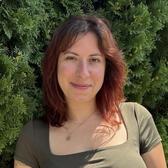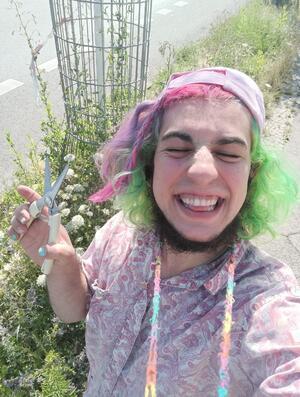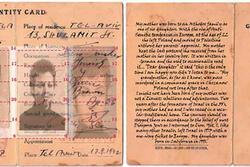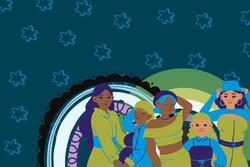7 Questions for Hani Portner
JWA sat down with Hani Portner, a multidisciplinary queer, trans, Jewish, disabled artist working in Berlin, Germany.
JWA: How did you first get interested in art?
Hani Portner: I was very lucky as a child and had a family that valued creativity and art, and put me into art and music classes. I have memories painting large sheets of paper bigger than me, and I still have a pinchpot I made with tiny fingers on my living room table.
My great grandmother, Helen Berland, was a talented oil painter and fashion designer. The H in my name is from her, and her detailed, bold, and realistic paintings were hung all over my childhood home. When I was able to dress myself I started constructing outfits and was encouraged to wear what I wanted. When I was seven, I started knitting and sewing. My grandmother, Marlene Joy Indictor, lovingly taught me how to put together garments and make my own clothes while telling me stories of the dresses she created. Throughout elementary school I learned new techniques, sewed my first dress, made lots of fabric sculptures out of old socks and shirts, and knit over 100 scarves.
I started a blog at age twelve, and for years published weekly observations, musings, poems, fashion DIYs, outfits, and outlooks on the broader world. I have always been deeply inspired by my Nana Dinah Berland, an incredible poet and editor who re-popularized Fanny Neuda’s book, Hours of Devotion: Fanny Neuda’s Book of Prayers for Jewish Women. As I got older I started taking more advanced art classes in many other mediums, always returning to work that brought me joy and connection to the artistic traditions and legacies of my family. I now find so much life in performing drag, playing with gender, and exploring ancestral histories, plants, fauna, and fungi through art and monthly guided tours in Berlin.
JWA: What does being Jewish mean to you?
HP: Being Jewish is getting to be joyfully connected. The incredible rabbi who married my wonderful wife Mara and me was the director of the summer camp I attended for seven years. How amazing is that?! To me, being Jewish is celebrating our joy, our hardships, and our growth—connected throughout time. Being Jewish means being part of a very large and beautiful tree of history, people, culture, language, love, art, stories, and laughter. It means being resilient and learning and growing through community. I am so incredibly proud to be descended from my ancestors who are descended from their ancestors who have kept the traditions of our collective ancestors alive and blossoming for thousands of years, despite constant genocide, persecution, and attempts to dim the light we continue to shine.
JWA: At what point did you start incorporating your Jewish and queer identities into your art?
HP: One of my first memories of making art for/about Jewishness as a queer person was sewing my bat mitzvah dress. I still refer to this as my bat mitzvah despite not using she/her pronouns anymore because I think it is very significant to acknowledge the history of bat mitzvahs. My Nana was the first in her congregation to have a bat mitzvah in June 1954 (Temple Emanu-El B’ne Jeshhurun in Wisconsin).
I knew that my bat mitzvah was very special and significant, so I decided to make a dress that is to this day one of the most skillfully difficult artistic pieces I have ever made. My incredibly kind and talented sewing teacher and mentor, Peymie Esfandiari, looked over my sketch. It was a tight-fitting, one-shoulder-strap-number with a diagonal rainbow across my chest. She told me that she and I could make my dream come true. We decided it was time to try silk! Silver silk for the body, and red, orange, yellow, green, blue, and purple transparent silk for the rainbow sash, bottom frills, and attached scarf. I used a technique called rouching, which took dozens of hours to fix the rainbow to the dress.
Wearing it on the bimah was such a proud moment. I knew I was queer then, which is why I put a giant queer flag on my dress. The next year, when I was fourteen, I would come out to my classmates by dyeing my whole head of hair rainbow. I now I sign all my paintings with an overlapping pink and blue triangle, forever marking my art through the lens of my Jewishness and transness.
JWA: What brought you to Berlin?
HP: After Trump was elected in 2016, I knew that I needed to leave America. So I moved to Berlin in August 2018 right after I graduated high school to pursue a Liberal Arts degree. I was fortunate enough to live with a host family in Freiburg for a summer when I was 15 and I glimpsed what living in Germany could be like. At that age, I was an out and proud bisexual, had bright rainbow hair, and had a travel watercolor set and sketchbook overflowing with observations about how free, accepted, and grounded I felt. I was experiencing the wonderful fullness of being at ease in the very country that my grandfather had told me never to visit. Of course, I was in a very idealistic, protected, and progressive university town.
Unfortunately, I have since learned from personal experience about the very real dangers Jewish and queer people in Germany face every day. I came out to myself as transgender in 2016, but was shunned by the high school gay student union because I was nonbinary, and didn’t fit the mold they wanted. It took until the end of 2018, once I was 5,637 miles away for me to come out at my school as trans, genderqueer, and nonbinary, and started using they/them pronouns full time. Two months after I moved to Berlin I started doing drag. I am the proud child of Judy La Divina, Israeli-Berlin drag queen mother and legend. I found community, love, friends, confidence, and magic in the Berlin drag and performance scene.
JWA: A lot of your work connects Judaism, queerness, the Holocaust, and environmentalism together. Could you share a bit about what the intersection of these concepts means to you?
HP: I spent time a lot of time in the woods of Berlin during the COVID-19 lockdown. I started to think about the stories of Jewish partisans like Faye Shulmann, who was put into the role of a nurse with no medical experience. She had to learn how to heal her brigade with little resources, and drew upon herbal remedies and forest craft. I thought about what people would eat when they lived in the woods, what skills they had to learn, and who would have taught them these things. I started to get interested in mushroom identification as a way to connect with the wild food of the region, and I wanted be a resource to my community.
As my knowledge grew, I started offering tours combining Berlin’s Jewish history, the history of Jewish partisans, and antisemitism with my knowledge of edible and medicinal plants and mushrooms. Because I am queer, Jewish, disabled, and autistic, my tours are accessible, trauma-informed, Jewish run, LGBT focused, and celebratory spaces. Last fall, I took participants deep into the Tegel forest to look for seasonal mushrooms. As we sat in a circle passing around photos of Jewish partisans, a member of the tour told me that her grandmother was a Partisan. After her grandmother left Poland, she never ate another mushroom, worried that without proper mushroom identification knowledge she might collect ones that weren’t edible. I do my work because of these stories and for the kismet of having her grandchild on my tour.
Whenever I am out doing my errands, I pass by hundreds of homes that were once owned by Jews. The names of the people are laid out in brass plates called stumbling stones. I try to take photos and research each one I find. There are millions more stones that have not yet been set, stories not brought to light, and networks not yet remembered. I hope to shine some light on these stories and connect with the ruach, the strength, of our spirit to live in the country that tried to put out our flame.
JWA: Many of the tours that you lead draw on Talmud, Sefirot, and Torah. Are there any particular passages that are the most compelling to you and your work?
HP: I am really inspired by tzedakah in its meaning of justice and righteousness, and see access to wild edible food knowledge as an important part of how I contribute to the cycle of giving. I offer my events by donation or trade. Sometimes people pay me with money, other times with poetry, tattoos, seeds, socks, and art supplies. I want participants to feel welcome and valued for what they bring to the space.
Yevamot 64a from the Talmud also greatly validates what I know to be true. When I say the amidah, I am calling upon my ancestors who were like me: Jewish, and trans. I love this passage because it says so clearly that Sarah was aylonit [a talmudic understanding of transfeminine identity], and both Sarah and Abraham were considered tumtumim [a person whose sexual characteristics are indeterminate or obscured]. The eight genders of Judaism are real, alive, strong, and recorded in our texts and commentary, and that is powerful. We have always been here and we will always be here!
JWA: Ranging from drag to painting to foraging to poetry, your work is truly multi-disciplinary. Is there any one medium that you have felt especially drawn to recently?
HP: Since we moved into our apartment last year, I have been really into the art of nesting—creating soft, gay, and comforting spaces in my home with my amazing wife Mara and our sweet kitty Boba Baruch Shlomo: the art of care work. I paint murals on our walls, cook luscious foraged dinners, and make wands with protective plants like mugwort and hawthorn to hang on door ways. I make skin salves from foraged herbs, like clover and plantain, to give to my friends and community. I have found love and stability in a place that I was told would be impossible to thrive in after everything that has happened. I am proud to be like the inspiring morel mushroom, fruiting in abundance after disaster.








